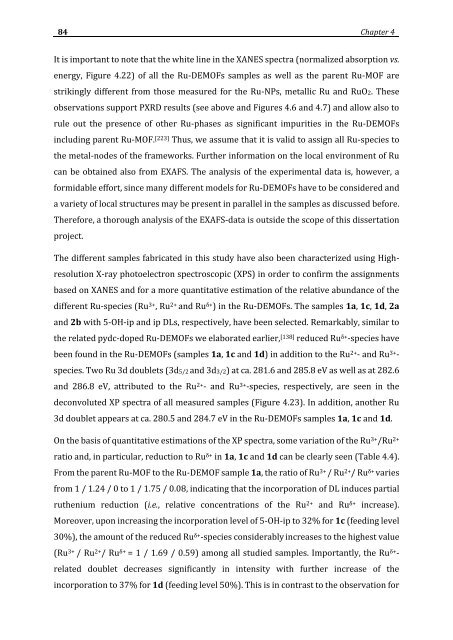Create successful ePaper yourself
Turn your PDF publications into a flip-book with our unique Google optimized e-Paper software.
84 Chapter 4<br />
It is important to note that the white line in the XANES spectra (normalized absorption vs.<br />
energy, Figure 4.22) of all the Ru-DEMOFs samples as well as the parent Ru-MOF are<br />
strikingly different from those measured for the Ru-NPs, metallic Ru and RuO2. These<br />
observations support PXRD results (see above and Figures 4.6 and 4.7) and allow also to<br />
rule out the presence of other Ru-phases as significant impurities in the Ru-DEMOFs<br />
including parent Ru-MOF. [223] Thus, we assume that it is valid to assign all Ru-species to<br />
the metal-nodes of the frameworks. Further information on the local environment of Ru<br />
can be obtained also from EXAFS. The analysis of the experimental data is, however, a<br />
formidable effort, since many different models for Ru-DEMOFs have to be considered and<br />
a variety of local structures may be present in parallel in the samples as discussed before.<br />
Therefore, a thorough analysis of the EXAFS-data is outside the scope of this dissertation<br />
project.<br />
The different samples fabricated in this study have also been characterized using Highresolution<br />
X-ray photoelectron spectroscopic (XPS) in order to confirm the assignments<br />
based on XANES and for a more quantitative estimation of the relative abundance of the<br />
different Ru-species (Ru 3+ , Ru 2+ and Ru δ+ ) in the Ru-DEMOFs. The samples 1a, 1c, 1d, 2a<br />
and 2b with 5-OH-ip and ip DLs, respectively, have been selected. Remarkably, similar to<br />
the related pydc-doped Ru-DEMOFs we elaborated earlier, [138] reduced Ru δ+ -species have<br />
been found in the Ru-DEMOFs (samples 1a, 1c and 1d) in addition to the Ru 2+ - and Ru 3+ -<br />
species. Two Ru 3d doublets (3d5/2 and 3d3/2) at ca. 281.6 and 285.8 eV as well as at 282.6<br />
and 286.8 eV, attributed to the Ru 2+ - and Ru 3+ -species, respectively, are seen in the<br />
deconvoluted XP spectra of all measured samples (Figure 4.23). In addition, another Ru<br />
3d doublet appears at ca. 280.5 and 284.7 eV in the Ru-DEMOFs samples 1a, 1c and 1d.<br />
On the basis of quantitative estimations of the XP spectra, some variation of the Ru 3+ /Ru 2+<br />
ratio and, in particular, reduction to Ru δ+ in 1a, 1c and 1d can be clearly seen (Table 4.4).<br />
From the parent Ru-MOF to the Ru-DEMOF sample 1a, the ratio of Ru 3+ / Ru 2+ / Ru δ+ varies<br />
from 1 / 1.24 / 0 to 1 / 1.75 / 0.08, indicating that the incorporation of DL induces partial<br />
ruthenium reduction (i.e., relative concentrations of the Ru 2+ and Ru δ+ increase).<br />
Moreover, upon increasing the incorporation level of 5-OH-ip to 32% for 1c (feeding level<br />
30%), the amount of the reduced Ru δ+ -species considerably increases to the highest value<br />
(Ru 3+ / Ru 2+ / Ru δ+ = 1 / 1.69 / 0.59) among all studied samples. Importantly, the Ru δ+ -<br />
related doublet decreases significantly in intensity with further increase of the<br />
incorporation to 37% for 1d (feeding level 50%). This is in contrast to the observation for
















